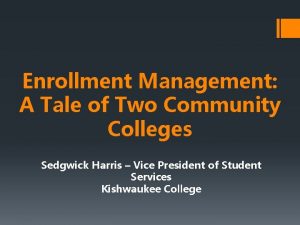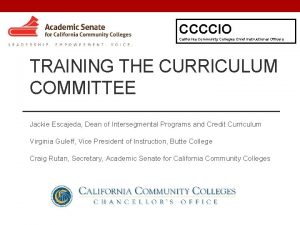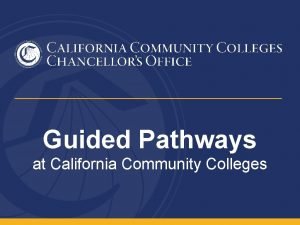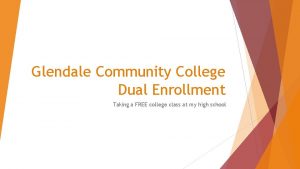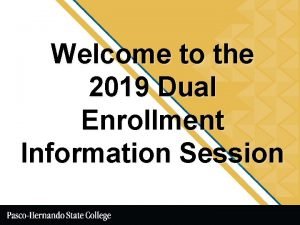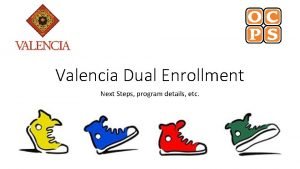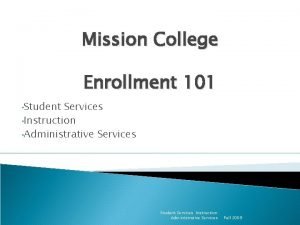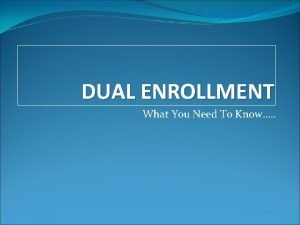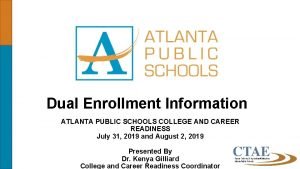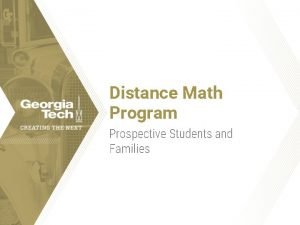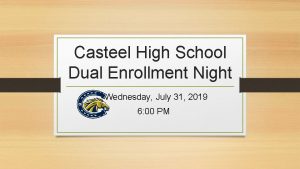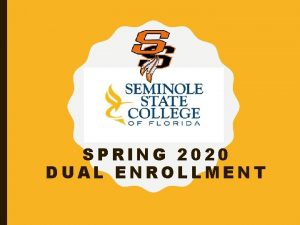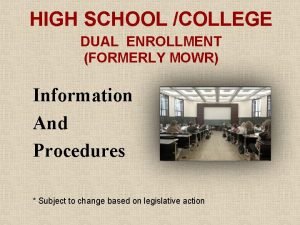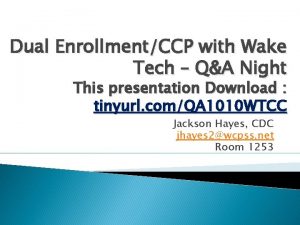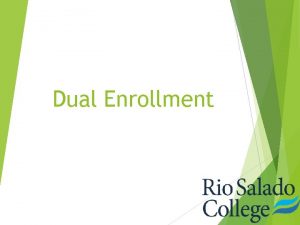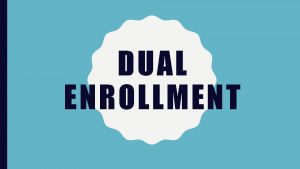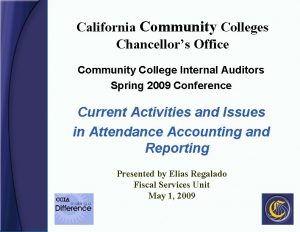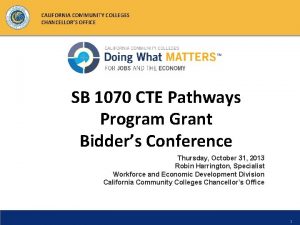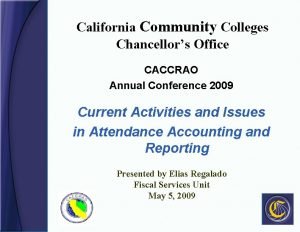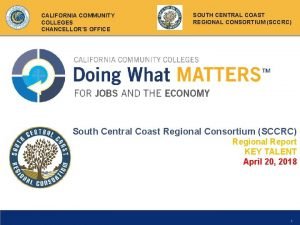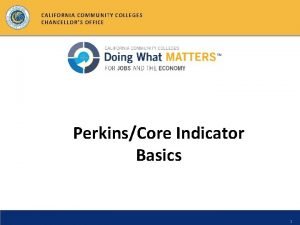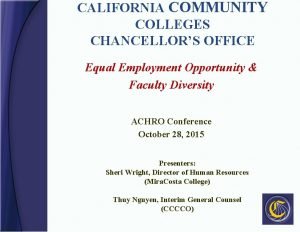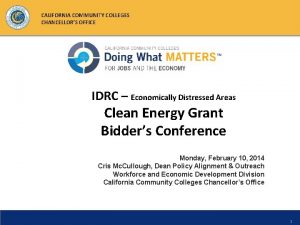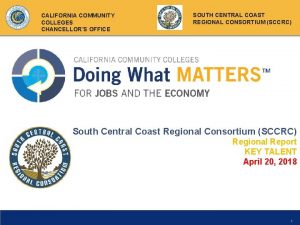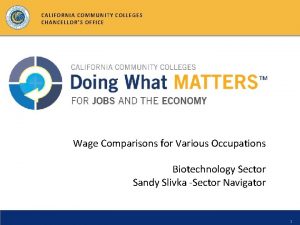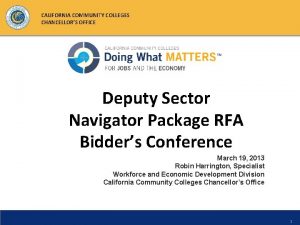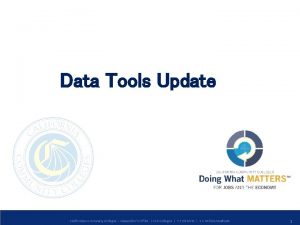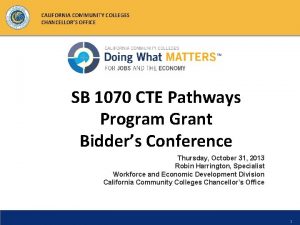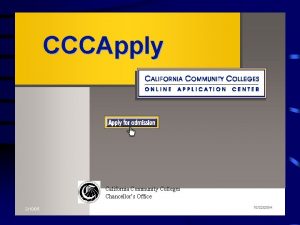CALIFORNIA COMMUNITY COLLEGES CHANCELLORS OFFICE DUAL ENROLLMENT OVERVIEW






















- Slides: 22

CALIFORNIA COMMUNITY COLLEGES CHANCELLOR'S OFFICE DUAL ENROLLMENT OVERVIEW CCIA SPRING CONFERENCE MAY 4, 2017 Natalie Wagner, College Finance and Facilities Planning Division Rosa de Anda, Governmental Relations Division

OVERVIEW § Historical context on issues related to special-admit students § Legislation aimed to create dual enrollment, concurrent enrollment, change the status of special-admit students § Then and now… Moving from SB 338 to AB 288 § In 2003, SB 338 (Scott) was a game changer in terms of reigning in improper campus practices regarding dual enrollment. Fourteen years later, AB 288 was also a game changer in that it broadened the scope of dual enrollment programs to students not traditionally bound for a college education.

HISTORICAL CONTEXT § Late 1990’s rapid expansion of special-admit students § December 12, 2002 Orange County Register – a series of articles highlighting concurrent enrollment abuse – phantom courses, physical education, missing parental approval, etc. § Formal complaints filed with the Chancellor’s Office § 2002 -03 Governor and legislature respond with an initial $80 M budget reduction; settle on $25 million reduction to “send the community colleges a strong message” against the abuse. § State Chancellor’s Office Report to the Legislature

2003 STATE CHANCELLOR’S OFFICER REPORT Chief complaints & findings: 1. No actual course work offered to special-admit students. 2. “Double dipping” whereby the state paid both the school district and the community college for the same activity. 3. Evidence of coercion of high students to enroll in college courses. 4. Courses not open to the public – violation of the Title 5, 51006 Open Course regulation 5. Parental permission slips not on file. 6. Permission of high school principal not obtained. 7. Proliferation of physical education courses whereby entire high school teams enrolled in the PE courses.

LEGISLATION REGARDING DUAL ENROLLMENT 2003 SB 338, Scott. Concurrent enrollment of pupils in high school and community college (Chaptered). 2006 SB 1303, Runner. Pupils: concurrent enrollment: high school: community college (Chaptered). 2005 AB 2050, Canciamilla. Pupils: concurrent enrollment in high school and community college. 2005 AB 2434, Coto. Pupils: concurrent enrollment of pupils in high school and community college. 2007 AB 1409, Portantino. Pupils: concurrent enrollment in community college and secondary or elementary school. 2013 AB 1146, Morrell. Pupils: concurrent enrollment in secondary school and community college. 2014 AB 1540, Hagman. Concurrent enrollment in secondary school and community college. 2014 AB 1451, Holden. Public schools: concurrent enrollment in secondary school and community college. 2015 AB 288, Holden. Public schools: College and Career Access Pathways (CCAP) partnerships (Chaptered). 2015 AB 889, Chang. Concurrent enrollment in secondary school and community college STEM. 2015 AB 482, Harper. Concurrent enrollment in secondary school and community college Computer Science. 2016 AB 526, Holden. Pupils: summer attendance at community college (Chaptered). 2016 AB 2364, Holden. Tuition Exemption Concurrently Enrolled Students (Chaptered).

LINKED LEARNING ALLIANCE “We essentially treat dual enrollment in California almost like a felony, ” said Christopher Cabaldon, executive director of the Linked Learning Alliance. From 1997 to 2003, Mr. Cabaldon was vice chancellor of the California Community Colleges System.

RESEARCH DRIVEN

AB 288 COLLEGE AND CAREER ACCESS PATHWAYS (CCAP) Establishes the College and Career Access Pathways (CCAP) partnerships whereby governing boards of a community college district and school district can enter into an agreement to expand the enrollment of special-admit students for preparation to transfer or career technical education. Highlights: Redefined student eligibility, expands participation, increases the maximum unit load, allows for teachers and professors to engage in teaching special-admit students and more…

THEN AND NOW… SB 338 (Scott) AB 288, Holden (CCAP) Reformed special-admit, concurrent enrollment Establishes the College and Career Access Pathways partnership and codifies the term dual enrollment. Student eligibility – restricted to those students Expands student eligibility to include: underachieving students from groups underrepresented in postsecondary education and those seeking career technical education. programs and FTES funding. who could benefit from “advanced scholastic or vocational work…” Target: high achieving students Waives enrollment fees up to 15 units per term – a maximum of 4 courses. Unit load – up to 11. 99 units per semester Allows closed courses on a high school campus during the regular school day and enrollment limited to eligible high school students. Title 5, 51006 Open Course requirement Allows CCCs to claim apportionment for students enrolled in closed courses. 5% summer session 10% annual statewide cap on FTES in dual enrollment coursework. Physical education restrictions apply Permits P. E. courses to be offered if they are necessary to complete program, major, or graduation requirements

CCAP PARTNERSHIP REQUIREMENTS § Legislation is explicit on the requirements of the CCAP partnership and stipulates the terms and conditions of the agreement. § Requires Board approval with two mandated open public meetings. § Annual reporting by participating community college district and school district – total number of FTE students, student demographic data, course offerings by school site, § Allows for priority registration consistent with legal provisions assigned to middle college high school students.

KEY SUBSEQUENT LEGISLATION MOTIVATED BY OR DIRECTLY RELATED TO AB 288 AB 2364 (Holden) requires a community college district to exempt all special part-time students, as specified, from nonresident fees and allows these students to be reported as resident full-time equivalent students (FTES) to receive associated state apportionments. AB 526 (Holden) clarifies that the 5% cap on the number of high school pupils in a school district that may enroll in a community college summer session does not apply to pupils who are concurrently enrolled as part of a College and Career Access Pathways (CCAP) program in which a majority of the pupils served are either low income, English learners, or foster youths.

AVAILABLE RESOURCES Dual Enrollment Toolkit Partnership between the RP Group, Career Ladders Project, and The Chancellors Office. Created the DE Toolkit with links to available references. http: //www. careerladdersproject. org/areas-of-focus/pathways/ccccode/

COMPARISON CCAP Dual Enrollment vs. Non-CCAP Dual Enrollment

PURPOSE OF DUAL ENROLLMENT Non-CCAP Providing advanced scholastic and vocational training to students who are determined to be ready to undertake college credit coursework. CCAP Expanding dual enrollment for students who may not already be college bound or who are underrepresented in higher education.

GOALS OF DUAL ENROLLMENT Non-CCAP Providing opportunities for eligible K 12 students to benefit from advanced scholastic or vocational course work. CCAP Must address at least one of the following goals: Developing seamless pathways from high school to community college: for Career Technical Education (CTE) or transfer preparation, to improve high school graduation rates, or to help high school students achieve college and career readiness.

APPORTIONMENT Non-CCAP Districts may claim apportionment for FTES generated by resident students and nonresident special parttime students exempted from nonresident tuition pursuant to AB 2364 for courses that are open to the general public. If the course is offered on a high school campus, it shall not be held during the time the campus is closed to the general public. (ECS 76002(a)) CCAP Districts may claim apportionment for FTES generated by CCAP resident students and CCAP nonresident special part-time students exempted from nonresident tuition pursuant to AB 2364 for courses offered on the college campus and on a high school campus. Courses held on a high school campus during the regular school day may be closed to the general public, otherwise must be open to the general public. (ECS 76004(o)) Both CCAP and Non-CCAP The course and FTES generated must comply with all other applicable statutory or regulatory requirements related to claiming the attendance of Special Admit students. References: ECS 76001, 76002, 76003, 76004, Legal Opinion 16 -02

ENROLLMENT FEES Non-CCAP Special part-time students (up to 11. 99 units) District may establish policy to exempt special part-time students from paying enrollment fees pursuant to ECS 76300(f) CCAP Special part-time students (up to 15 units/4 courses): District must exempt students from enrollment fee and other fees specified in ECS 76004(q)

NONRESIDENT TUITION Both CCAP and Non-CCAP Pursuant to AB 2364 (Holden, Chapter 299, Statutes of 2016; Ed. Code, § 76140) and effective January 1, 2017, Districts must exempt all qualifying nonresident special part-time students (other than those with a non-immigrant status) from the nonresident tuition fee.

AB 2364: NONRESIDENT TUITION FEE WAIVER FOR SPECIAL PART-TIME STUDENTS (HOLDEN EC § 76004 AND 76140) Effective January 1, 2017, modified provisions of SB 150 Requires community college districts to exempt all qualifying nonresident special “part-time” students (other than those with a nonimmigrant status, such as those present in the United States on a B visitor Visa) from the nonresident tuition fee (ECS 76140(a)(4)) Note: As it relates to the exclusion of nonimmigrant students from the exemption, as an interpretation of AB 2364, the CCCCO has determined nonresident special part-time students that hold a T or U non-immigrant visa would NOT be excluded from this required nonresident tuition fee exemption and qualifying special part-time students must reside in California during the period of attendance

AB 2364: NONRESIDENT TUITION FEE WAIVER FOR SPECIAL PART-TIME STUDENTS (HOLDEN EC § 76004 AND 76140) Expressly allows districts to report the attendance of nonresident students who are exempted from the nonresident tuition fee pursuant to this section as resident FTES for apportionment purposes. (ECS 76140(j)) New nonresident tuition fee provisions are applicable to both CCAP and Non-CCAP tracks

CONTRACTED DISTRICT AUDIT MANUAL (CDAM) COMPLIANCE ITEM 427 DUAL ENROLLMENT Compliance Item 427 Dual Enrollment (CCAP and Non-CCAP) was updated in the CDAM for the 2016 -17 fiscal year primarily to incorporate the new provisions of AB 288 CCAP dual enrollment. Compliance Item 427 includes background, criteria, compliance requirements, and suggested audit procedures for both CCAP and non-CCAP dual enrollment.

Thank You!
 Community colleges
Community colleges Ccccio conference
Ccccio conference California community college chief instructional officers
California community college chief instructional officers Cccco guided pathways
Cccco guided pathways Dual enrollment gcc
Dual enrollment gcc Chancellors school
Chancellors school Phsc pert
Phsc pert Nova dual enroll
Nova dual enroll Ggc dual enrollment
Ggc dual enrollment Valencia class registration
Valencia class registration Ung ap credit
Ung ap credit Mission college dual enrollment
Mission college dual enrollment Zelda glazer
Zelda glazer Dual enrollment pellissippi
Dual enrollment pellissippi Fau dual enrollment classes
Fau dual enrollment classes Atlanta public schools transcript request
Atlanta public schools transcript request Dual enrollment mc
Dual enrollment mc Georgia tech math dual enrollment
Georgia tech math dual enrollment Casteel dual enrollment
Casteel dual enrollment Chattahoochee tech dual enrollment
Chattahoochee tech dual enrollment Ssc dual enrollment
Ssc dual enrollment Gwinnett tech dual enrollment classes
Gwinnett tech dual enrollment classes Ccp wake tech
Ccp wake tech
